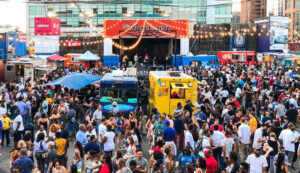Washington, D.C.’s Most Powerful Works of Art Are No Longer in Its Museums

Image courtesy of GW Today
By Jessica Fetrow
Washington, D.C. has long been known as a hub for both contemporary and historic pieces of art. The District has no shortage of celebrated architecture, such as the Washington Monument, Lincoln Memorial, Jefferson Memorial, and Capitol Building, as well as world-renowned museums, such as the National Portrait Gallery, Smithsonian American Art Museum, Hirshhorn Museum, and Renwick Gallery. However, in recent months, the District’s most potent and compelling works can no longer be found within the walls of its distinguished museums; instead, they can be found on building walls, bridges, monuments, sidewalks, and homemade posters of demonstrators.
After the murder of George Floyd on May 25, 2020, millions of protesters flooded the streets nationwide in the midst of a pandemic to protest the excessive use of force on Black Americans and institutional racism plaguing America, including the nation’s capital. With these protests emerged a new wave of art painted across the city fueled by the frustration and exhaustion of generations of Americans. Illustrated across the prestigious monuments were displays of exasperation, disgust, indignation, and affliction; more specifically, spray-painted across the steps leading up to the Lincoln Memorial read the words screamed out by millions of Americans: “Y’all not tired yet?”
Image courtesy of Fox 13 Tampa Bay
The reactions to this widespread graffiti were mixed even after the graffiti was removed and the monuments were returned to their proper states. Although surely illegal, the public’s opinions about the graffiti clashed over its validity. Was it justified because of the circumstances surrounding its creation? Or does it irrevocably disrespect the property, history, and our country?
The purpose of this article is not to explore the legality or morality of this graffiti; under federal law, it is unlawful to deface government or personal property. It is, however, to highlight the importance of this graffiti through its expression and emotion as a reflection of contemporary society.
According to the Oxford Dictionary, art is defined as “the expression or application of human creative skill and imagination, typically in visual form such as painting or sculpture, producing works to be appreciated primarily for their beauty or emotional power.” By this definition, the recent widespread defacing of these properties falls comfortably under the categorization of art, and from this socio-political unrest comes arguably some of the most powerful works of art the District has ever seen, whether or not its creation is lawful.
Image courtesy of KUT
However, it’s not just the art of vandalism that has been capturing the emotions of Americans recently. On Saturday, November 7, 2020, the Associated Press called the 2020 presidential election in favor of Democratic nominee Joseph R. Biden nearly five days after Election Day, and celebrations ensued all over the nation, particularly in front of the White House along Black Lives Matter Plaza. A street previously filled with protesters carrying homemade signs made from Sharpie markers, poster board, and dismantled cardboard, expressing the sadness and vexation of the American people, was suddenly overflowing with similarly homemade signs, but this time soaked in champagne and celebration.
Photo courtesy of WBUR
Just beyond Black Lives Matter Plaza lies the White House, which has been surrounded by extensive precautionary fencing for years. What once was a mark of freedom and representation of the Leader of the Free World is now isolated from the public in which it intends to serve. However, the fencing intended to keep the people out has turned into a voice for the people, decorated in signs, posters, and powerful works of art once again capturing this moment in history.
Image courtesy of the DCist.com
Art is created and viewed as a manifestation of emotion, vehemence, and expression that allows for an expressive understanding of the world around us. From the riots and protests last spring to the recent celebratory congregations, art has emerged in several non-traditional forms in the places that individuals would least expect. The duality of these events but the consistent forms of emotion portrayed through art shows the powerful impact that art has on history. Regardless of political preference, it is apparent that these demonstrations and works of art displayed at such events express a clear insight into the current status of American life, and will one day migrate from the demonstrations to history books and eventually within the boundaries of the District’s renowned museums.





